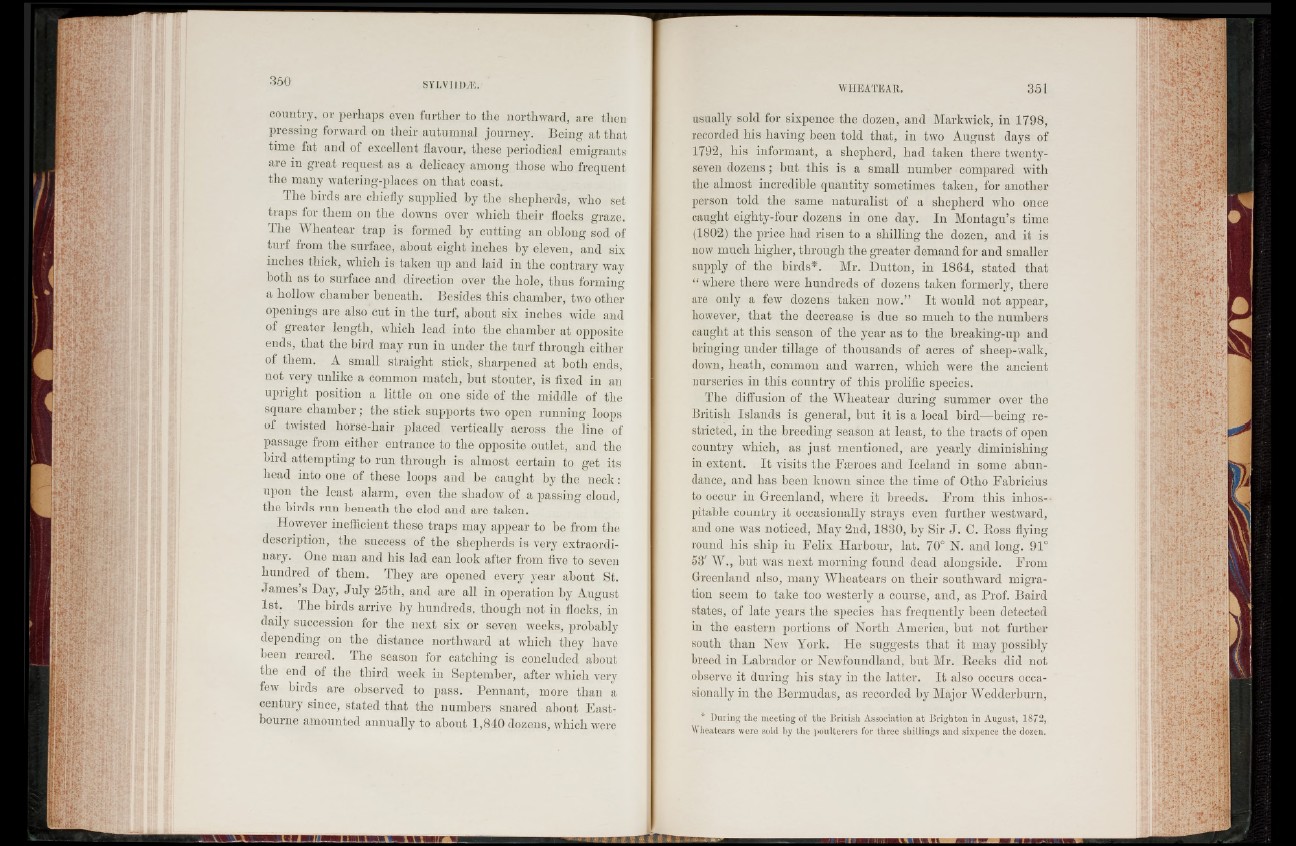
country, or perhaps even further to the northward, are then
pressing forward on their autumnal journey. Being at that
time fat and of excellent flavour, these periodical emigrants
are in great request as a delicacy among those who frequent
the many watering-places on that coast.
The birds are chiefly supplied hy the shepherds, who set
traps for them 011 the downs over which their flocks graze.
The Wheatear trap is formed hy cutting an oblong sod of
turf from the surface, about eight inches hy eleven, and six
inches thick, which is taken up and laid in the contrary way
both as to surface and direction over the hole, thus forming
a hollow chamber beneath. Besides this chamber, two other
openings are also cut in the turf, about six inches wide and
of greater length, which lead into the chamber at opposite
ends, that the bird may run in under the turf through either
of them. A small straight stick, sharpened at both ends,
not very unlike a common match, but stouter, is fixed in an
upright position a little on one side of the middle of the
square chamber; the stick supports two open running loops
of twisted liorse-hair placed vertically across the line of
passage from either entrance to the opposite outlet, and the
bird attempting to run through is almost certain to get its
head into one of these loops and be caught by the neck:
upon the least alarm, even the shadow of a passing cloud,
the birds run beneath the clod and are taken.
However inefficient these traps may appear to be from the
description, the success of the shepherds is very extraordinary.
One man and his lad can look after from five to seven
hundred of them. They are opened every year about St.
James s Day, July 25tli, and are all in operation by August
1st. The birds arrive by hundreds, though not in flocks, in
daily succession for the next six or seven weeks, probably
depending on the distance northward at which they have
been reared. The season for catching is concluded about
the end of the third week in September, after which very
few birds are observed to pass. Pennant, more than a
century since, stated that the numbers snared about Eastbourne
amounted annually to about 1,840 dozens, which were
—
usually sold for sixpence the dozen, and Markwick, in 1798,
recorded his having been told that, in two August days of
1792, his informant, a shepherd, had taken there twenty-
seven dozens; but this is a small number compared with
the almost incredible quantity sometimes taken, for another
person told the same naturalist of a shepherd 'who once
caught eighty-four dozens in one day. In Montagu’s time
(1802) the price had risen to a shilling the dozen, and it is
now much higher, through the greater demand for and smaller
supply of the birds*. Mr. Dutton, in 1864, stated that
“ where there were hundreds of dozens taken formerly, there
are only a few dozens taken now.” I t would not appear,
however, that the decrease is due so much to the numbers
caught at this season of the year as to the breaking-up and
bringing under tillage of thousands of acres of sheep-walk,
down, heath, common and warren, which were the ancient
nurseries in this country of this prolific species.
The diffusion of the Wheatear during summer over the
British Islands is general, but it is a local bird—being restricted,
in the breeding season at least, to the tracts of open
country which, as just mentioned, are yearly diminishing
in extent. I t visits the Faroes and Iceland in some abundance,
and has been known since the time of Otho Fabricius
to occur in Greenland, where it breeds. From this inhos--
pitable country it occasionally strays even further westward,
and one was noticed, May 2nd, 1830, by Sir J . C. Ross flying
round his ship in Felix Harbour, lat. 70° N. and long. 91°
53' W., but Avas next morning found dead alongside. From
Greenland also, many Wheatears 011 their southward migration
seem to take too westerly a course, and, as Prof. Baird
states, of late years the species has frequently been detected
in the eastern portions of North America, but not further
south than New York. He suggests that it may possibly
breed in Labrador or Newfoundland, but Mr. Reeks did not
observe it during his stay in the latter. It also occurs occasionally
in the Bermudas, as recorded by Major Wedderburn,
During the meeting of the British Association at Brighton in August, 1872,
Wheatears were sold by the poulterers for three shillings and sixpence the dozen.